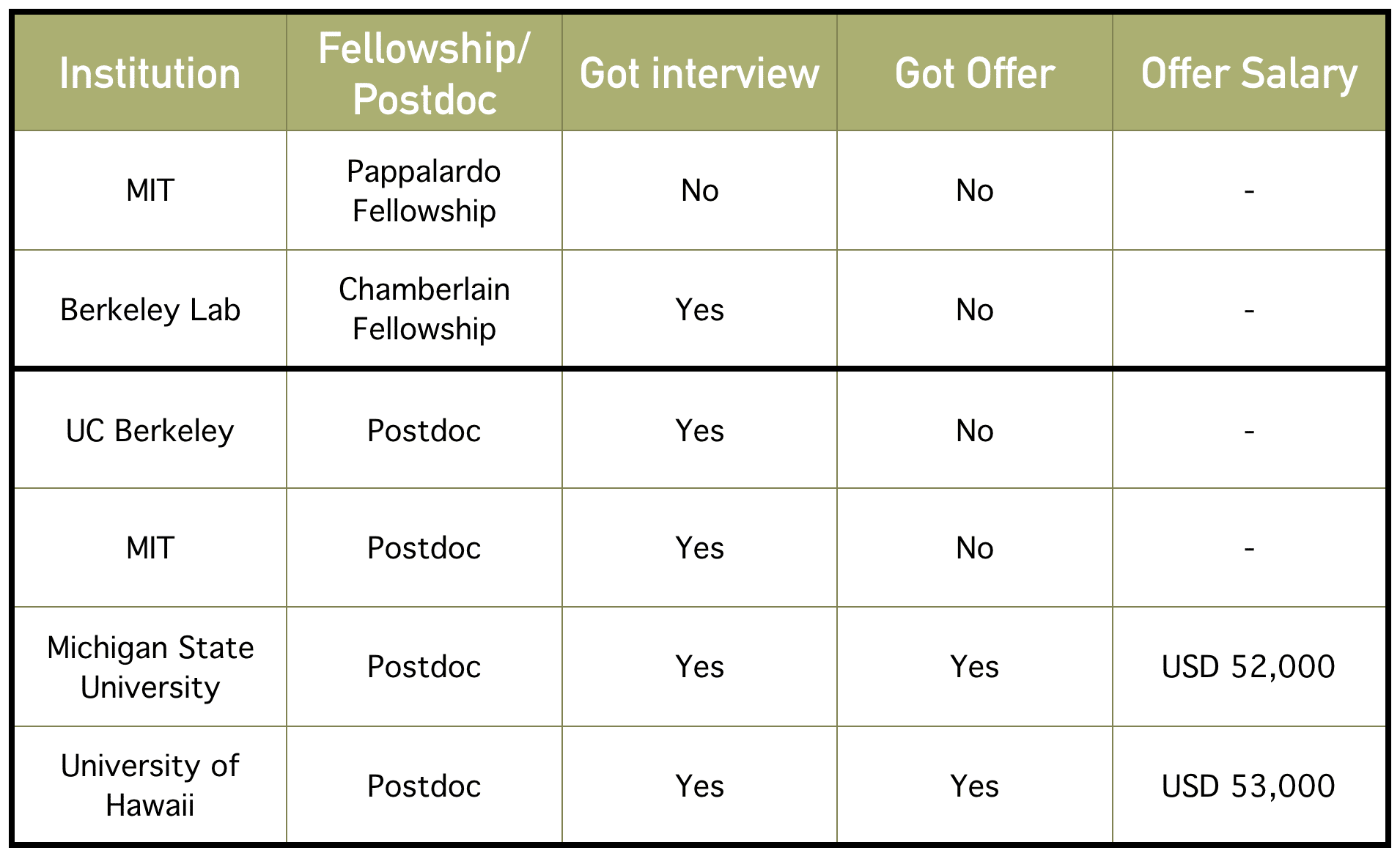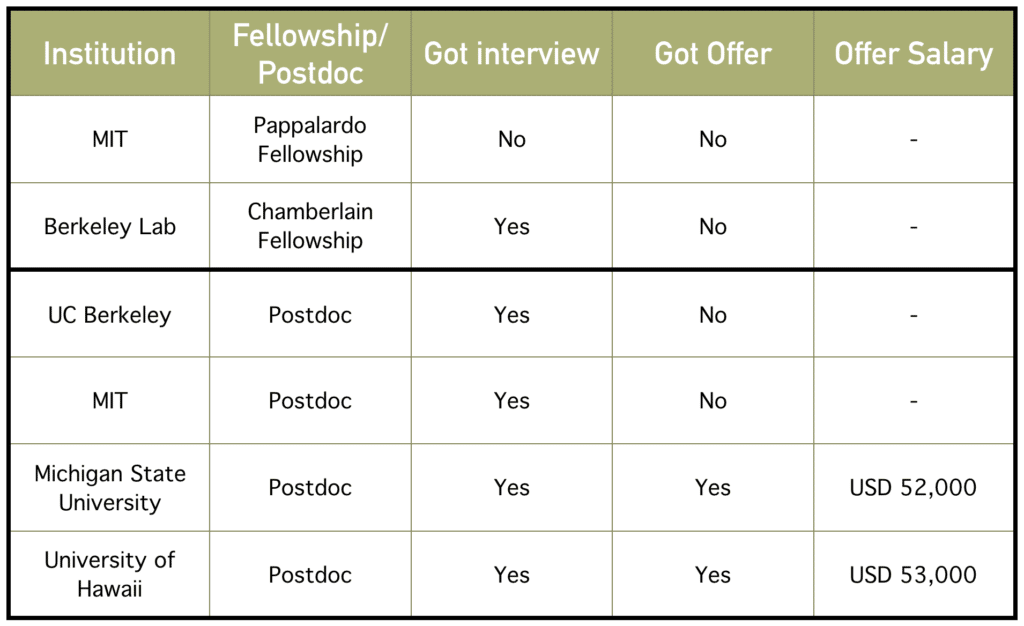|
Getting your Trinity Audio player ready…
|
The table here shows the summary of where I applied and what happened at each place including the two postdoc fellowships applications: MIT’s Pappalardo Fellowship and Berkeley Lab’s Chamberlain Fellowship. These were big competitions and sort of a huge deal to even get an interview for.
Then I also applied to a lab at UC Berkeley, a lab at MIT, the IceCube group at Michigan State University, and lastly, my Ph.D. research collaboration’s headquarters, University of Hawaii.
Long before actually applying to any postdocs, I had leads on some opportunities that I learned about through my network. I was (still am) part of a collaborative project spanning several institutions and I was able to build quite a large network of professors, postdocs, and other graduate students. All it takes is for someone relatively close to you to recommend you to someone they know is looking for a postdoc or to connect you with that person.
Story: Pappalardo Postdoc Fellowships Application
For the postdoc at MIT (just the normal one), I was approached by the professor herself at a big conference. We had met before when she came to give a talk at OSU and then we met again at the conference. One of my senior colleagues had informally recommended me to her and she came up to encourage me to apply to her position. So I did! That is how that particular position came to be known to me, literally from the person who was looking for that role to be filled.
I applied to her postdoc position as well as to the Pappalardo Fellowship position. I had five professors writing letters of recommendation for me. They started sending their letters to all the places where I was applying.
Now, sometimes, professors not only send letters to the official channel where you apply but also more personally to professors at that institution if they think they might be able to exercise more influence by doing so. My advisor told me that it is a pretty common practice.
Since I applied to two positions at MIT, the fellowship as well as directly with the professor, a confusing thing happened. My letter writers sent their letters to Pappalardo’s official application and then directly to the professor with whom I was also applying. In general, this would be fine even if I wasn’t applying to her postdoc because my letter writers were trying to help me make connections with the professor at that same school. Turns out this was a problem.
Pappalardo decided that letter writers were NOT allowed to directly contact any members of the committee deciding whether you get the fellowship or not. Soon after sending off my Pappalardo application, I got a stern-sounding email saying that letter writers were not allowed to directly approach any committee members, and I thought, weird, but OK. What I did not know yet was the professor I was applying with had ended up on the Pappalardo committee!
My letter writers had done nothing sketchy because they (or I) did not know about this conflict at all. Heck, no-one thought it would be a conflict either way but I suppose it was. I did not get the Pappalardo fellowship, did not even get an interview call. It is the only application that did not lead to an interview. It was also the only application where we (me and letter writers) had “messed up,” so I wonder if that played a role. If it did, that is stupid and it’s OK I did not get this opportunity.
Story: Chamberlain Postdoc Fellowships Application
As for the Chamberlain Fellowship, everyone was super surprised when I did hear back from them calling me for an interview. It was a huge, huge deal. I had simply applied in the normal way, with no inside connections or anything. I have shared the research statement from this successful application in this book in a previous chapter.
Interviewing at Berkeley Lab for the Chamberlain Fellowship was a lot of fun. I enjoyed my visit. I remember getting an Uber from the airport to the Lab and the Uber driver being nervous about entering the fortress that is this national lab, gated and guarded, and on a mountain. They had me stay in the guest house on the Lab’s campus and it was all very nice.
Several different research groups interviewed me at Berkeley Lab. Many of these interactions were quite informal and us just having a good time talking about the science and research I had done and what the researchers worked on at the Lab. Not only researchers, but I also spoke to some of the more administrative big wigs at the Lab, including people like the director and deputy director. It was my first experience visiting such a big national lab and it was well worth it. Plus, of course, they paid for the visit, and I got to see San Francisco.
The scary part about the interview visit at Berkeley Lab was giving a talk in their huge auditorium that could be attended by anyone from the Lab. I got up on stage and presented my research. The job talk example I have shared in the previous chapter is a later version of the talk I gave at Berkeley since the interview at Berkeley Lab was in January and the interview (over Skype) with Michigan State University was in May.
I am rather proud of myself for doing a great job at Berkeley Lab. There was a lot of pressure and no-one familiar when I interviewed there. Everything went well, including the job talk. I did great with presenting and also taking questions. I got a lot of compliments.
Given that I had my hopes up for actually winning the fellowship, it was heartbreaking when I did not. For whatever reason, the funding situation seemed pretty off that year at the Lab. Even during my visit, they were unable to say anything about funding and told me that they were yet to know whether there would be money for the Fellowship or not. I thought that it was strange that they were interviewing without knowing their funding situation, but I guess that’s just a fact of life.
They ended up giving the Chamberlain Fellowship to NO ONE that year. How interesting, but there you have it. I didn’t get the fellowship, after all that, but nobody got the fellowship that year.
Story: UC Berkeley Postdoc Application
For the postdoc position at UC Berkeley, I interviewed over Skype around late-November. This interview went well but as you notice, I am sure, this was at Berkeley. Not the Lab, but the school. Nonetheless, they are connected. That created an interesting situation.
The professor who was interviewing me asked me at the end of the interview when I could answer once she made her decision. She was super nice and it all sounded very positive, but it was only late November. When she insisted on getting a timeline, I had to tell her that I had applied to the Chamberlain Fellowship and had even gotten selected to come interview in January. I thought she should be understanding of this situation because a) it was a good thing I got selected for such a prestigious fellowship and should be allowed to interview, and b) it was a fellowship opportunity at an organization that she was associated with!
Unfortunately, life and the world are more complicated. I was transparent with her about my situation and gave her the date for the interview at Berkeley Lab, and she promptly decided to drop me and hire someone else for her position. I am sure there were good reasons for these things on her part. Her postdoc position needed to be filled and she needed to hear an answer before I could give her one. These things happen. So, UC Berkeley did not work out for me because of the Chamberlain Fellowship.
Imagine my disappointment when the Chamberlain Fellowship also did not work out, down the road. However, I will say this: I have no regrets with how I responded to UC Berkeley. I wanted to wait for the Berkeley Lab opportunity to pan out before I said “yes” to someone and that was the right decision for me. I cared about the position at Berkeley Lab more than the position at UC Berkeley. So I waited and gave it my best shot. That was worth it even if it didn’t work out. I did not settle for UC Berkeley when I could have.
Maybe you would have done differently. The odds of getting a fellowship are worse than that for getting a normal postdoc in a professor’s lab. So, for the practical purpose of having a postdoc if you want one, it might be more logical to say “yes” to whatever comes your way rather than waiting for the competitive one to work out. But I just didn’t feel it in my gut to say “yes” to UC Berkeley. I felt rushed to make a decision and when I feel that way my gut tells me to say “no.”
As for you, please take from this whatever lesson makes sense to you. I am sharing my story with honesty and transparency so that YOU know what is going on and so you are informed while making your decisions, whatever those may be.
If you think I made a mistake, well then, don’t make the same mistake. You can learn from mine.
To keep this post a semi-normal length, I write about the remaining applications in my next post.
Concluding remarks
I wrote this book about landing your dream postdoc when I myself did not do a postdoc. That is a fact of life. I may not have actually accepted a postdoc offer, but I did successfully apply and get offers. Now, I want YOU to reap all the benefits from these experiences in your academic journey, should you choose to go down that path. You have my full support no matter what path feels right at the moment.



Leave a Reply